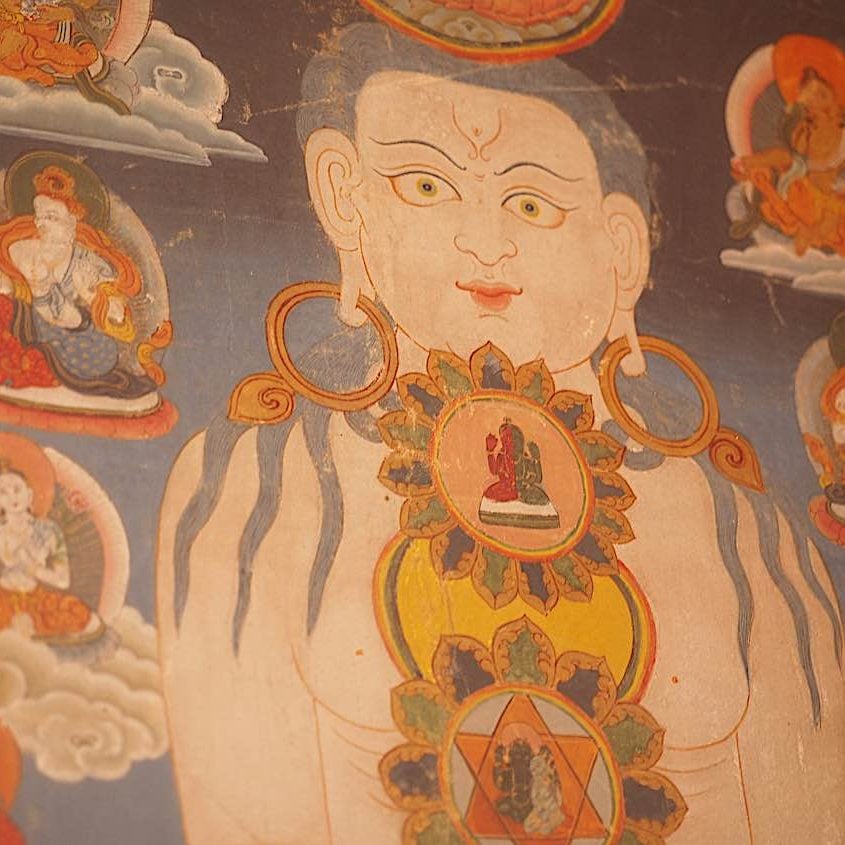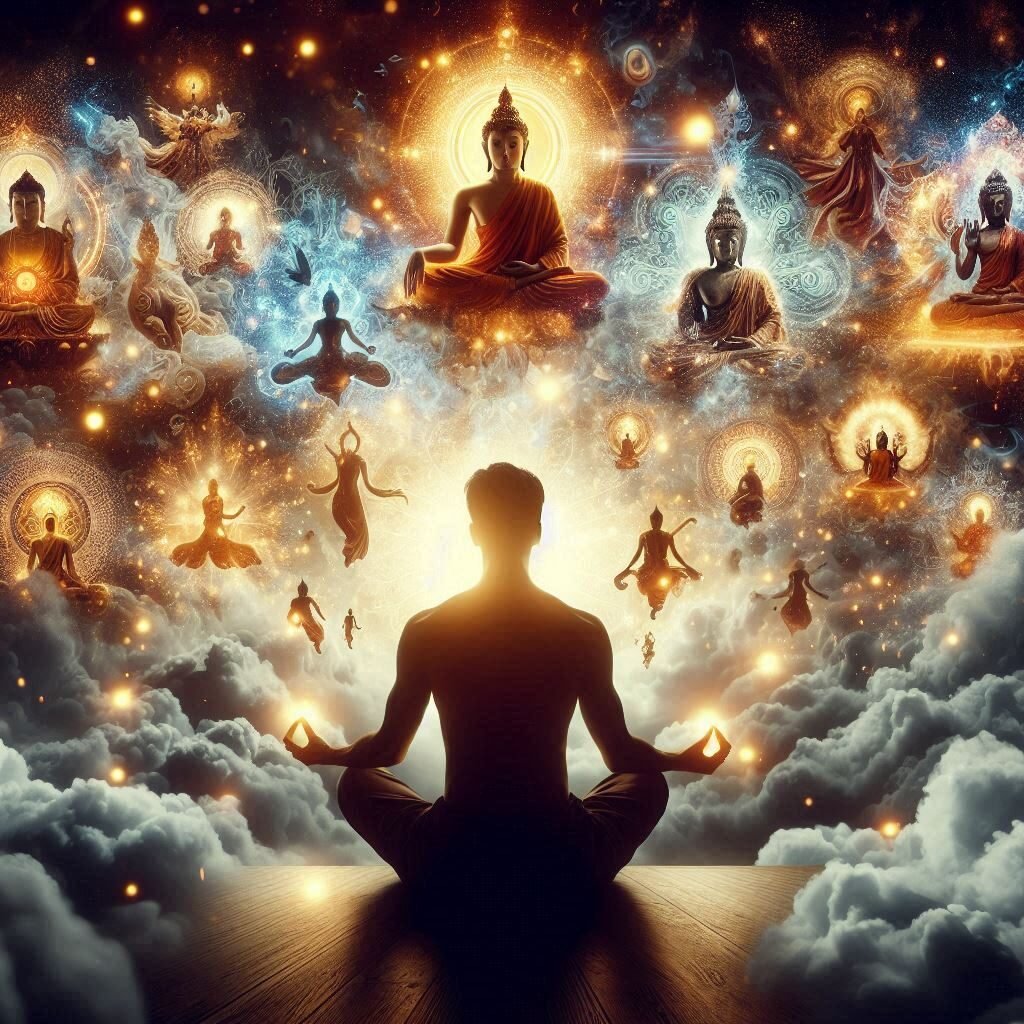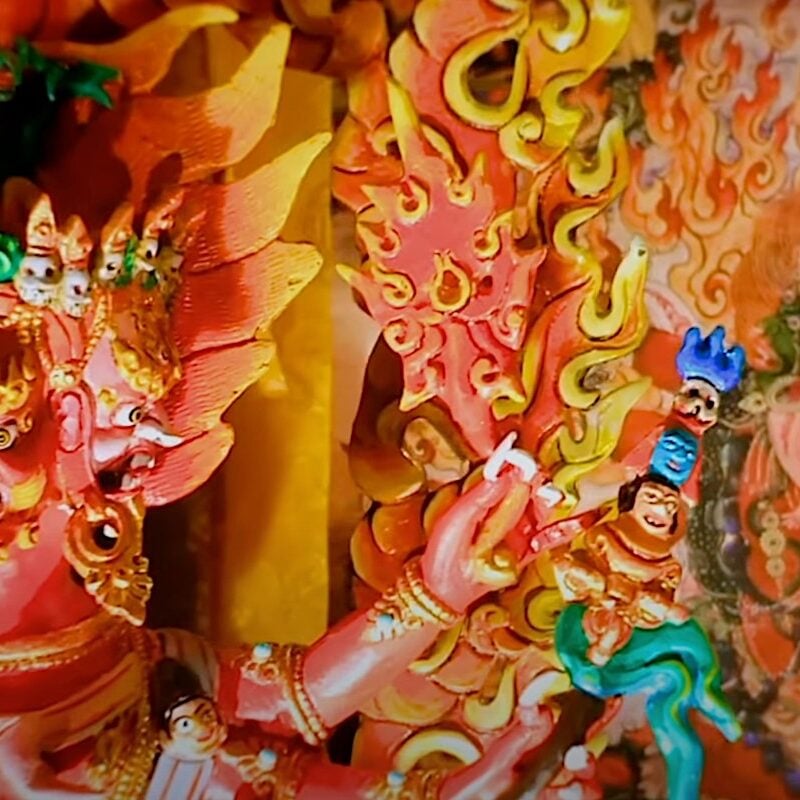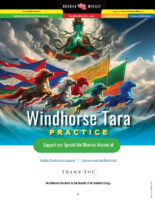In Vajrayana, the Four Directional Dignities — Garuda, Snow Lion, Tiger and Dragon — are not just for prayer flags; they are profoundly powerful guardians of our mind
The dragon rises out of the clouds, mouth open, teeth the size of swords, eyes glittering like jewels. You are flying on the back of a giant black raven, as this vast dragon circles around you, shaking all dimensions with his roar.
A beautiful snow lion leaps out of the clouds and into the fray, nipping at the feet of the great dragon — then, suddenly, rolling over playfully for a belly rub.
Then, a giant yellow tiger pounces on this playful snow lion, snarling. The three tumble through the clouds in play — while your raven desperately tries to avoid them. And all of them, suddenly break apart as a great Garuda plunges into their midst, talons outstretched, his cry the sound of thunder…
… and, you wake from your dream.
Or was it a dream? Were you visited by the Four Dignities? Did they have a message for you?
Note: This feature is slightly whimsical, sorry! Couldn’t help it!
The Four Dignities in Tibetan Buddhism and the auspicious animals of Bhutan: Tiger (Vraghra in Sanskrit) lower left Snow Lion (Seng) lower right, Garuda upper left and Dragon (Vritra, Skrt or Druk) upper right. These are four directional guardians with Garuda in the north, Snow Lion in the east, Tiger in the south and Dragon in the West. (In some regions, directions may be changed).
Dreaming of the Four Dignities
Traditionally, a dream of any one of the Four Great Ones would be auspicious. Even if we haven’t had such a dream, we can aspire to having such a fortunate vision in the future.
In Tibetan Buddhism, the four dignities are powerful and fantastical deities protecting not only our dreams, but our minds. They protect Buddhism and the Dharma. They protect each direction: Garuda in the north, Snow Lion in the east, Tiger in the south, and Dragon in the west. In Bhutan, they are more commonly — and affectionally — known as Chung, Seng, Tak and Druk, the “Four Guardians.” They are also known as the “Four Gods” or the “Four Auspicious Ones.” These wonderful, magical deities of Buddhism can be viewed as symbolic or spiritually real. In the Daily Bhutan, Ashley Chen explained[1]:
“The symbolism of animals contains a wealth of meaning in both social and religious contexts.”

In Bhutan, where the four Directional Deities are everywhere — painted on houses, ever-present at festivals, even used in advertising — the four great ones are especially treasured. On the Bhutan Natural website, they write[2]:
“Tak, Seng, Chung and Druk are four powerful and auspicious animals, namely Tiger, Snow Lion, Garuda and Dragon. These animals symbolize qualities like awareness, vision, confidence, joy and power. They can avert untoward situations in life.”

Garuda and Dragon, of these four mythical animals, are perhaps the best known to Buddhists outside of Tibet or Bhutan. Garuda — the king of birds — is mentioned frequently in sutras. Dragon makes appearances as awesome Nagas (who often protect Buddha) in Sutra, and is popular in Chan Buddhism and Zen Buddhism as celestial dragons. It is Buddha who “settles” the dispute between the Garudas and the Nagas — ancient enemies. Snow Lion is ubiquitous in Tibetan symbolism — and fiercely adorable. Tiger needs no introduction.
Four profound symbols — “sacred qualities”
There is no doubt they are emblems for concepts that are profound and important — in visual forms that resonate with our minds. They are real in the spiritual sense. They are so important, that they are known as the Four Dignities in Tibetan Buddhism. Together with Wind Horse, they appear on many of the beautiful prayer flags in Tibetan Buddhism — symbolically there to carry the wishes and prayers to all sentient beings on the wind. They also are the starring roles in many masked dances — the colorful masks of Chung Seng Tak Druk.
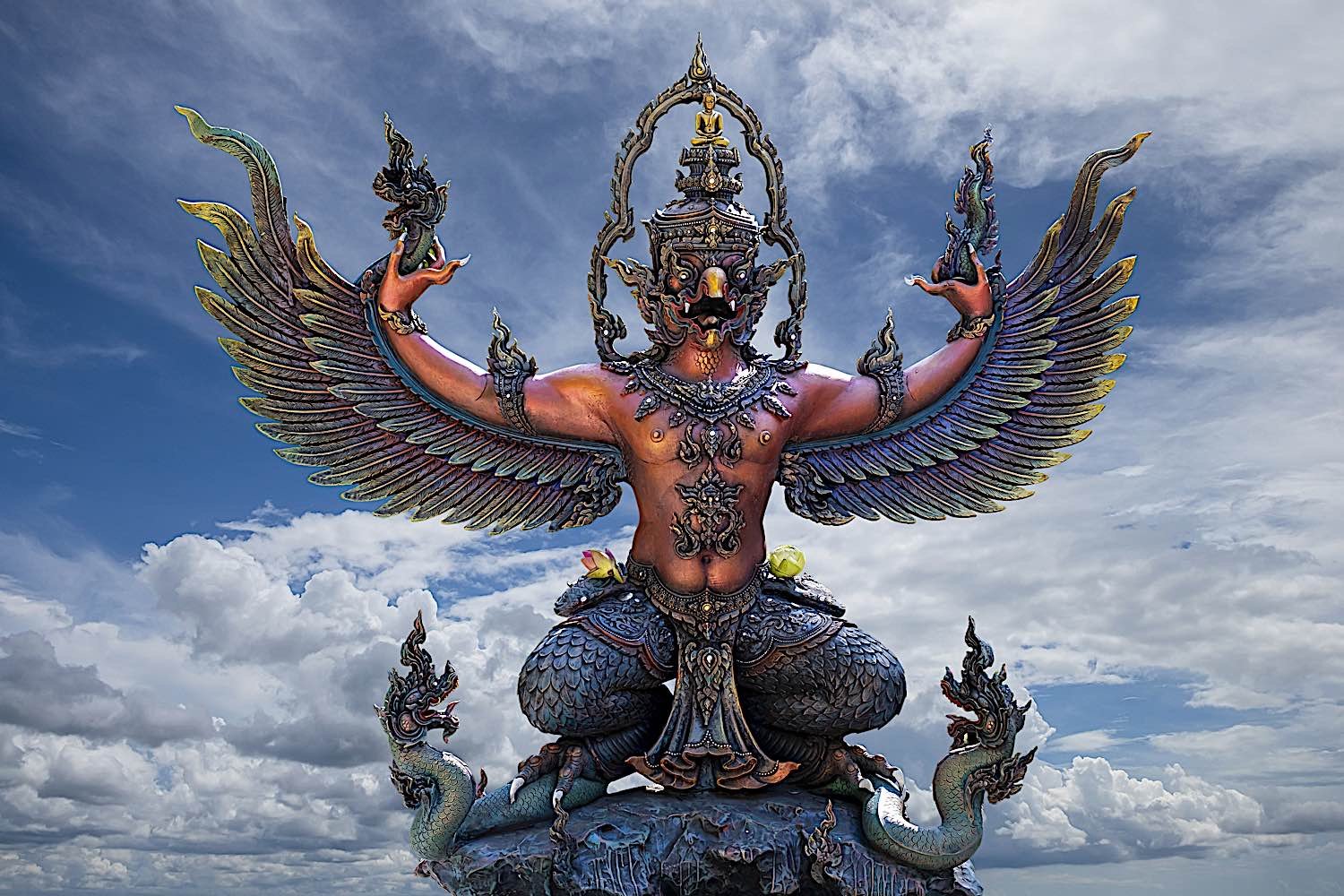
Ashley Chen summarised the sacred qualities:
“These mythical animals also represent the sacred qualities and attitudes that Bodhisattvas develop on the path to enlightenment – qualities such as awareness, vast vision, confidence, joy, humility, and power.
Garuda represents fearlessness, power and wisdom
Dragon represents elegance, generosity, calmness and achievements
Snow Lion represents vitality, dignity, lightness and purity
Tiger represents confidence, discipline and modesty.”
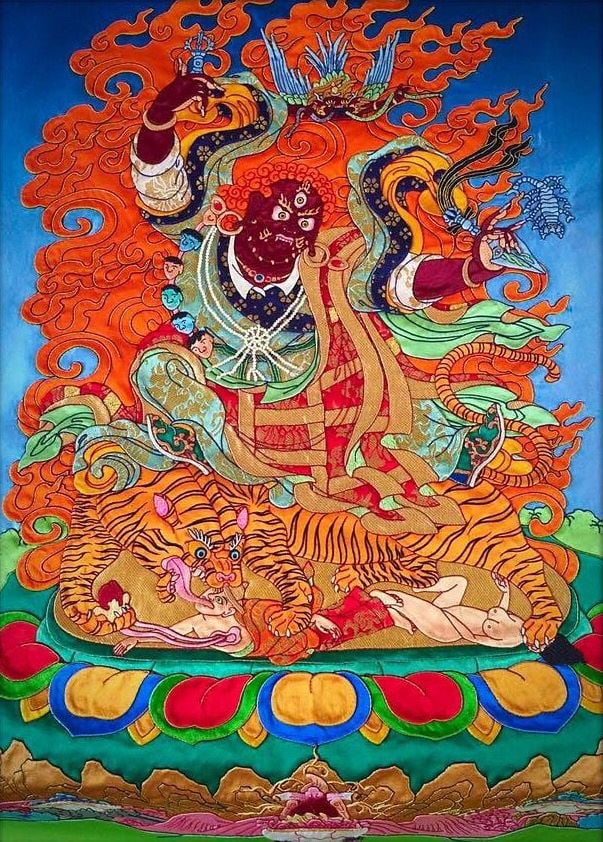
No dragons in your bedroom
No, a dragon is not likely to appear in your bedroom, but don’t be surprised if one flies into your dreams or even your waking meditations. You don’t have to believe they are “real” in the flesh-and-bones sense; but never doubt they exist in the ultimate reality of Oneness and Everythingness. They are powerful essences that exist in mind space — and, some believe, in other dimensions.

Fantasy, or real? You decide. But, have some fun with these beautiful Buddhist guardians. There is no denying they are beautiful, awesome, and magnificent, and stir the imagination. Embrace their essence and bring the power of Garuda, Snow Lion, Tiger and Dragon — and Raven — to your meditation cushion. Raven is often in the center — especially in Bhutan — and is associated with Black Mahakala, a ferocious form of the compassionate Lord Avalokiteshvara.
They are important in Shambala Buddhism, but no less well known and embraced by Buddhists of other traditions. In Bhutan, they are national protectors!
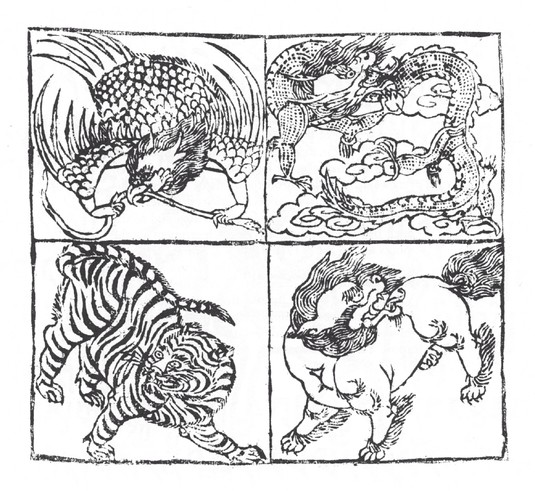
In Feng Shui, Chan Buddhism and Daoism there are the five celestial animals. These are slightly different — although dragon and tiger overlap — but are conceptually similar.
So, without further preamble, let’s plunge into the world of fantastical guardians, the “Totems” of Buddhism.
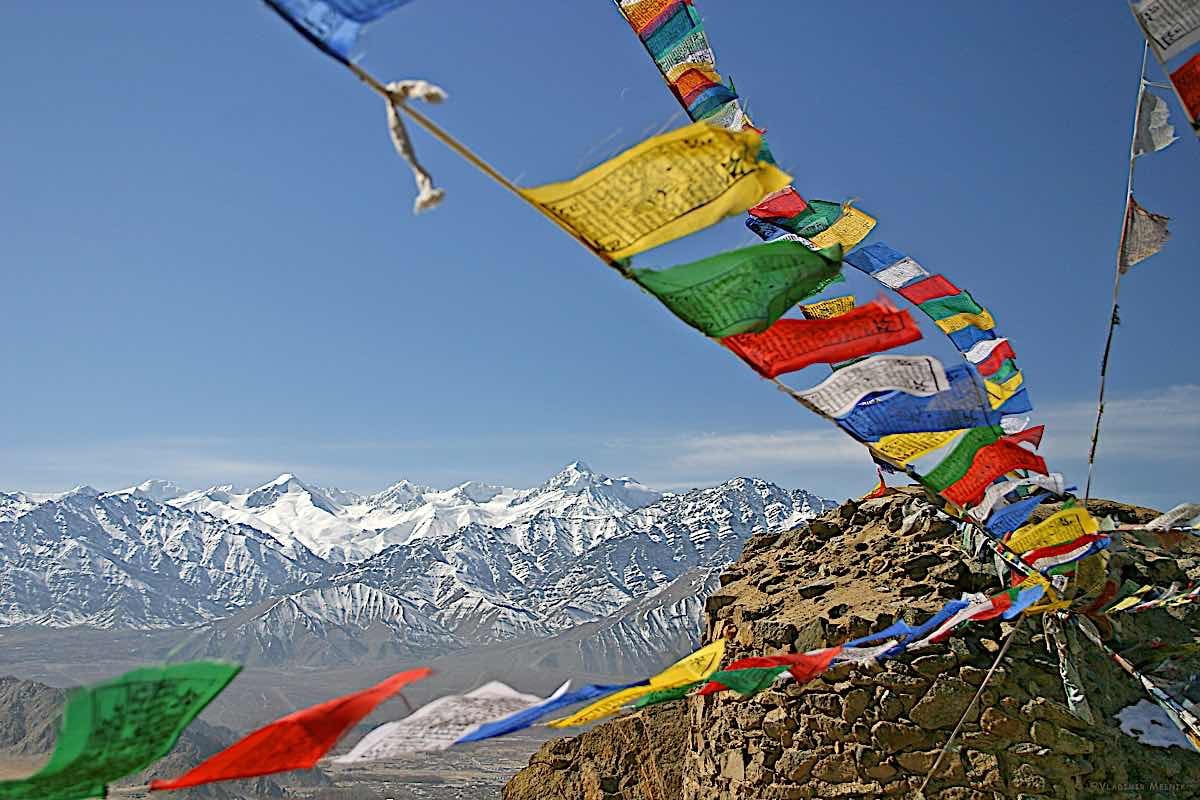
Not just for prayer flags — Garuda, Snow Lion, Tiger and Dragon
They do appear on nearly all prayer flags, together with mantras and the ever-present wind-horse in the center. In Bhutan they are elevated to “national animals” with Raven in the center (emblematic of Black Mahakala) instead of a wind-horse.
But, they are not just symbols. They are mind-guardians of the highest order.
In Tibetan Buddhism, the Four Dignities are intrinsically linked with the Four Elements — and thus with change, because all things are in a constant state of flux due to the interplay of the elements.

The Four Dignities also have an important role to play in tantric ritual practices. In fact, they are so important that they each have their own mudra (ritual hand gesture), mantra, color, season and sense organ associated with them.
They also have an outer, inner and secret aspect. The outer aspect is what we see in prayer flags and paintings; the inner aspect is the meditational deity or yidam; the secret aspect is the wisdom principle or dharmakaya.
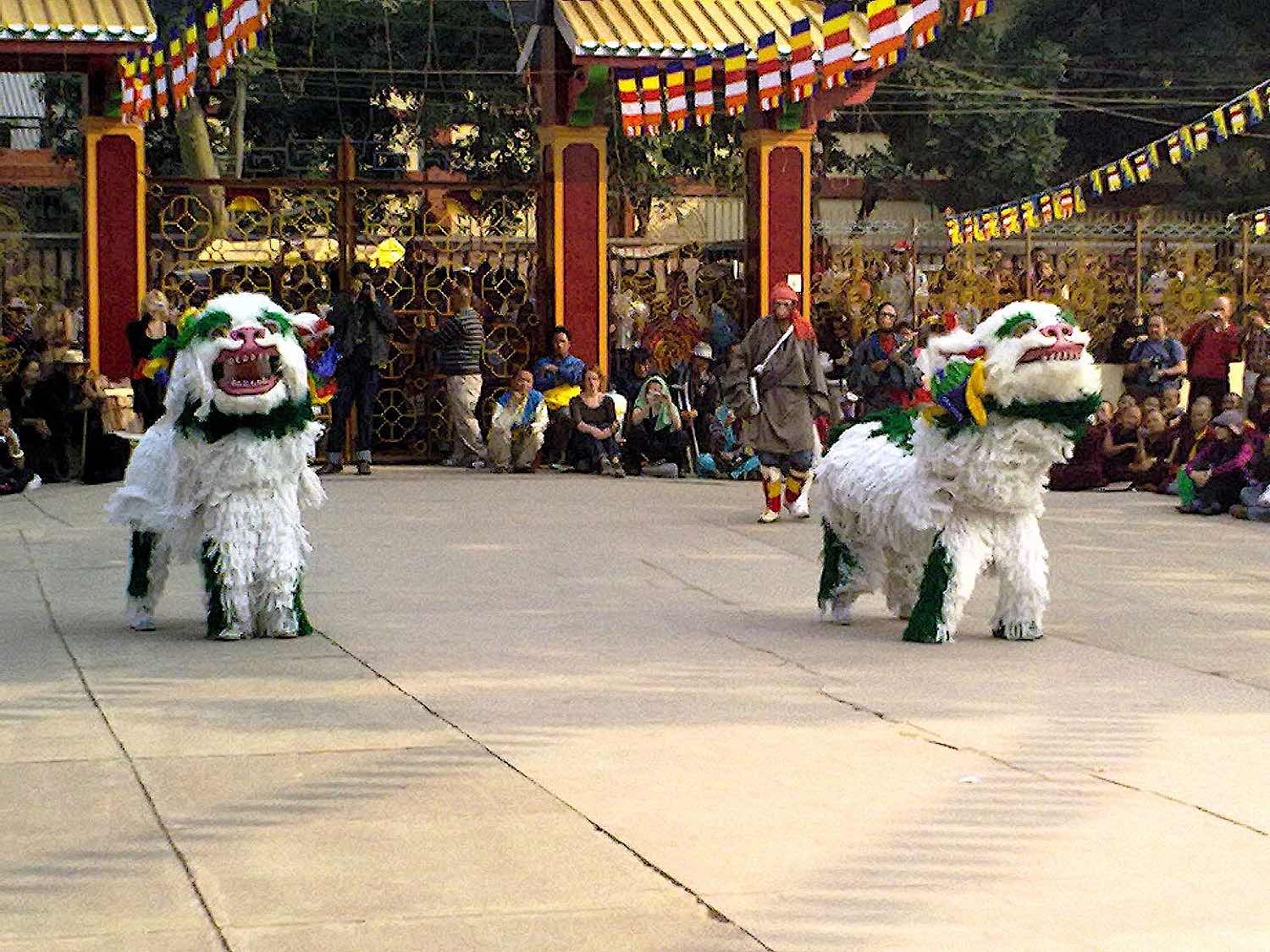
So, when you see a beautiful painting of a snow lion, for example, know that there is much more to it than meets the eye. It is not just an artistic representation; it is also a map for our journey inwards — and an embodiment of wisdom and power.
Note: In different lineages, the direction and color associations may vary — in some traditions, for example, east and center are exchanged.

The Four Animals of Dignity, plus one?
1) Garuda: Activity Power, North, Air/Wind Element, Green Tara and Amoghasiddhi Buddha, Green Color, Nose Sense Organ
2) Snow Lion: Pacifying Power, East, usually Akshobhya Buddha, Water Element, Eyes Sense Organ (In some lineages assoicated with Vairochana.)
3) Tiger: South, Increasing Power, Ratnasambhava Buddha, Earth Element, Yellow Color, Tongue Sense Organ
4) Dragon: Magnetizing Power West, Fire Element, Amitabha Buddha, Red Color, Spring Season, Body Sense Organ
And, in the center is Raven:
5) Raven: Center, Wrathful Power, Black Mahakala, Secret Aspect, Space.
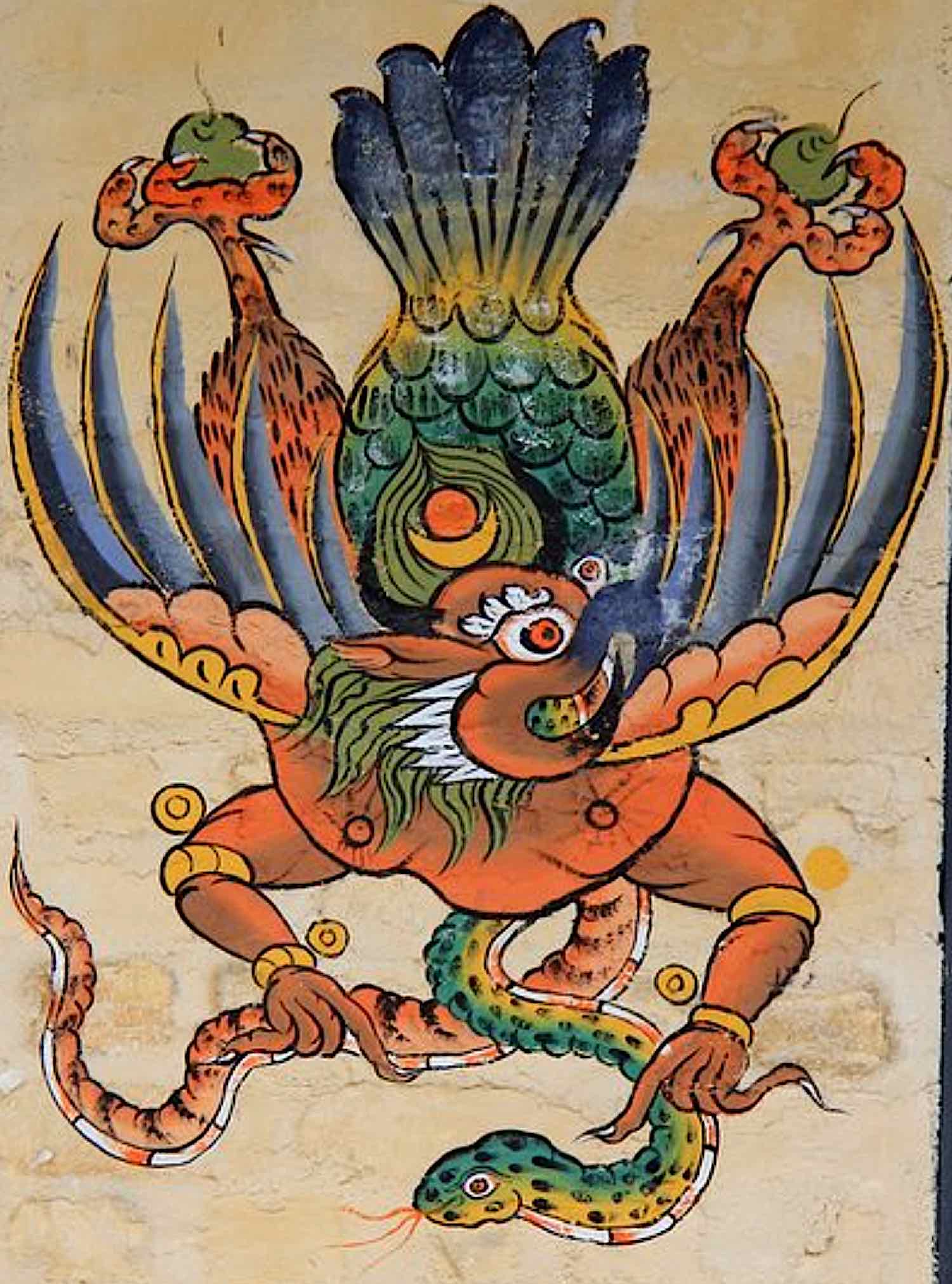
Garuda (Chung) — All-Seeing Watchful Protector
Garudas are always active — flying, swooping, watching. They aren’t just the wind of the north; they are virtual hurricanes of fearless energy.
Garuda represents fearlessness, power, and wisdom — most suitable for the guardian of the northern direction — the domain of fearless Noble Green Tara. Tara, the supreme Mother of Wisdom, therefore the Mother of the Buddhas, is Garuda’s queen. With the speed of his element, the wind, he can appear instantly anywhere, bringing his awesome protective power to the aid of Dharma practitioners — in a wonderous flash.
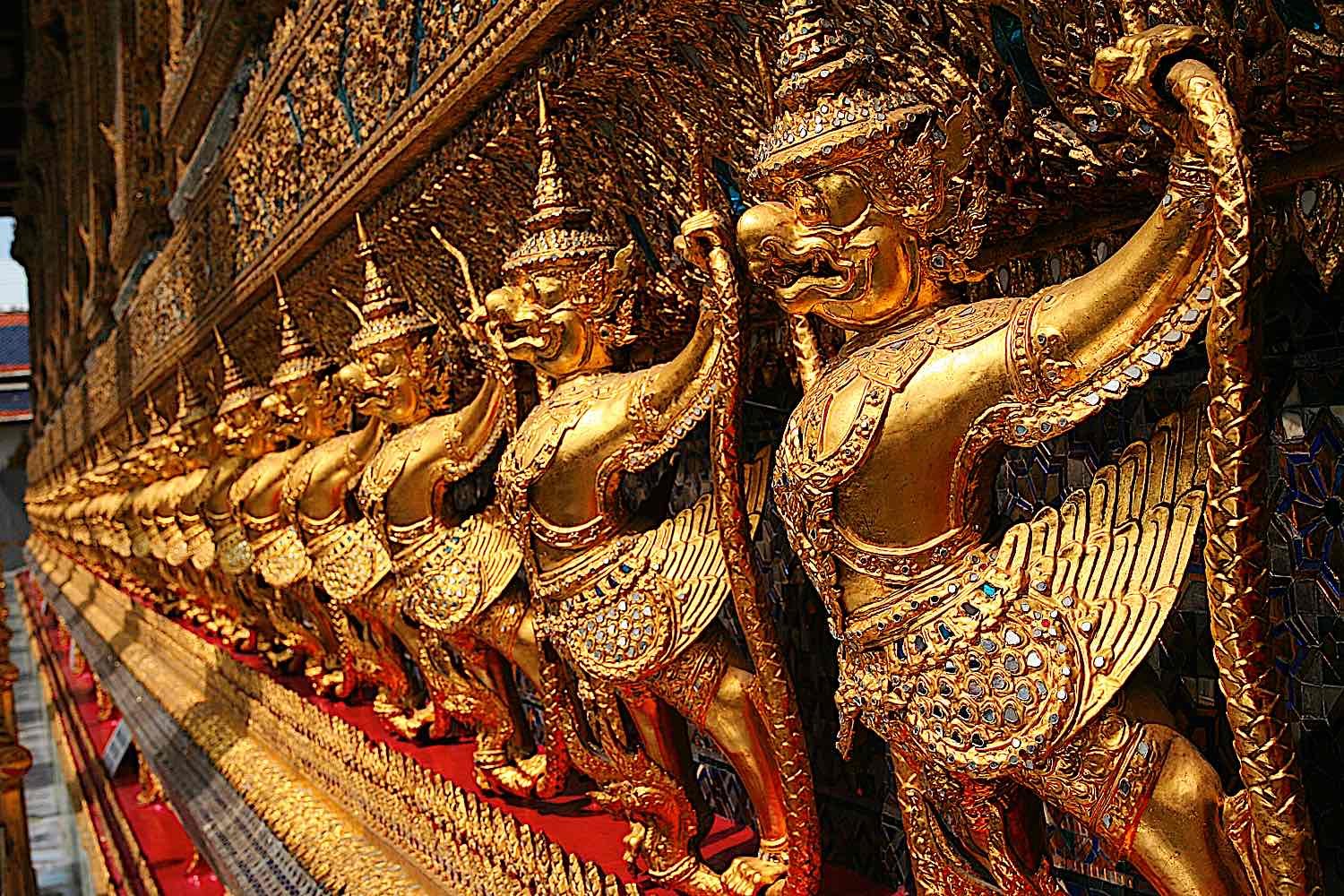
“The Garuda symbolizes power and courage; as the king of all birds, its presence averts illness and evil spells cast by the Nagas or the local deities.” [2]
Garuda, as the northern protector, is not necessarily the same as King Garuda, who is an Enlightened Deity in Tibetan Buddhism. Garuda is also strongly associated with Guru Rinpoche, and in some Nyingma traditions, Garuda is a manifestation of Padmasambhava.
As a protector of the north, and king of all the birds, Garuda does represent the wind and air element. In Buddhist and Hindu myth, Garuda is also an entire race of beings — as is the case with all of the Dignities.
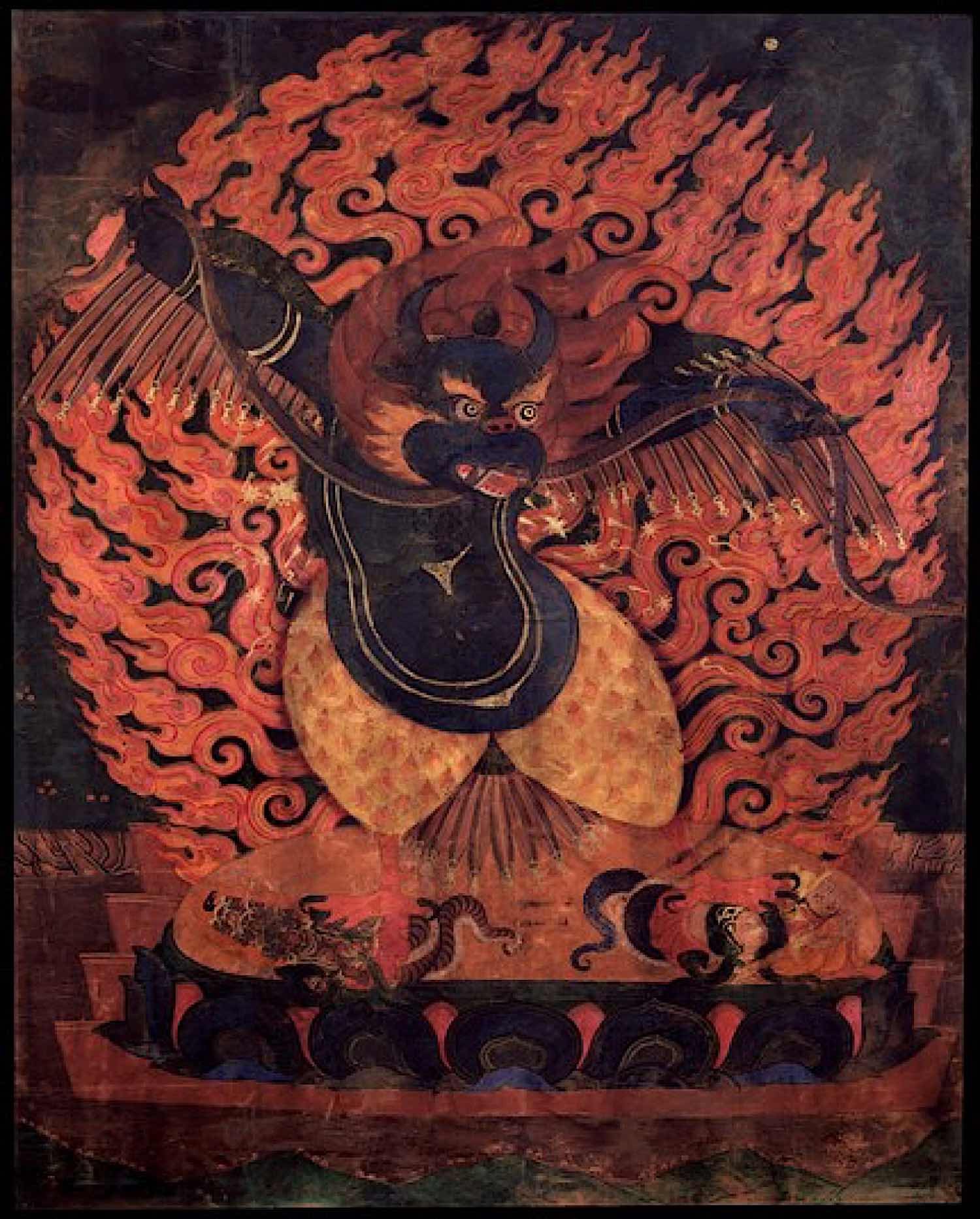
Garuda, as the wind element protector, represents the fearless power of the Windhorse, the wish-fulfilling horse. His home, mythically speaking, is the wish-fulfilling tree of life (Seen as the tree in the painting above depicting the four Dignities.)
Garuda is a shapeshifter. The wings of a Garuda can expand instantly to the size of a planet, and shrink to smaller than a dragonfly. He symbolically clutches two snakes (nagas) in his talons, representing his ability to destroy poisons and diseases. Garudas are hatched from an egg, fully grown. Once hatched, they can expand to any size at will.
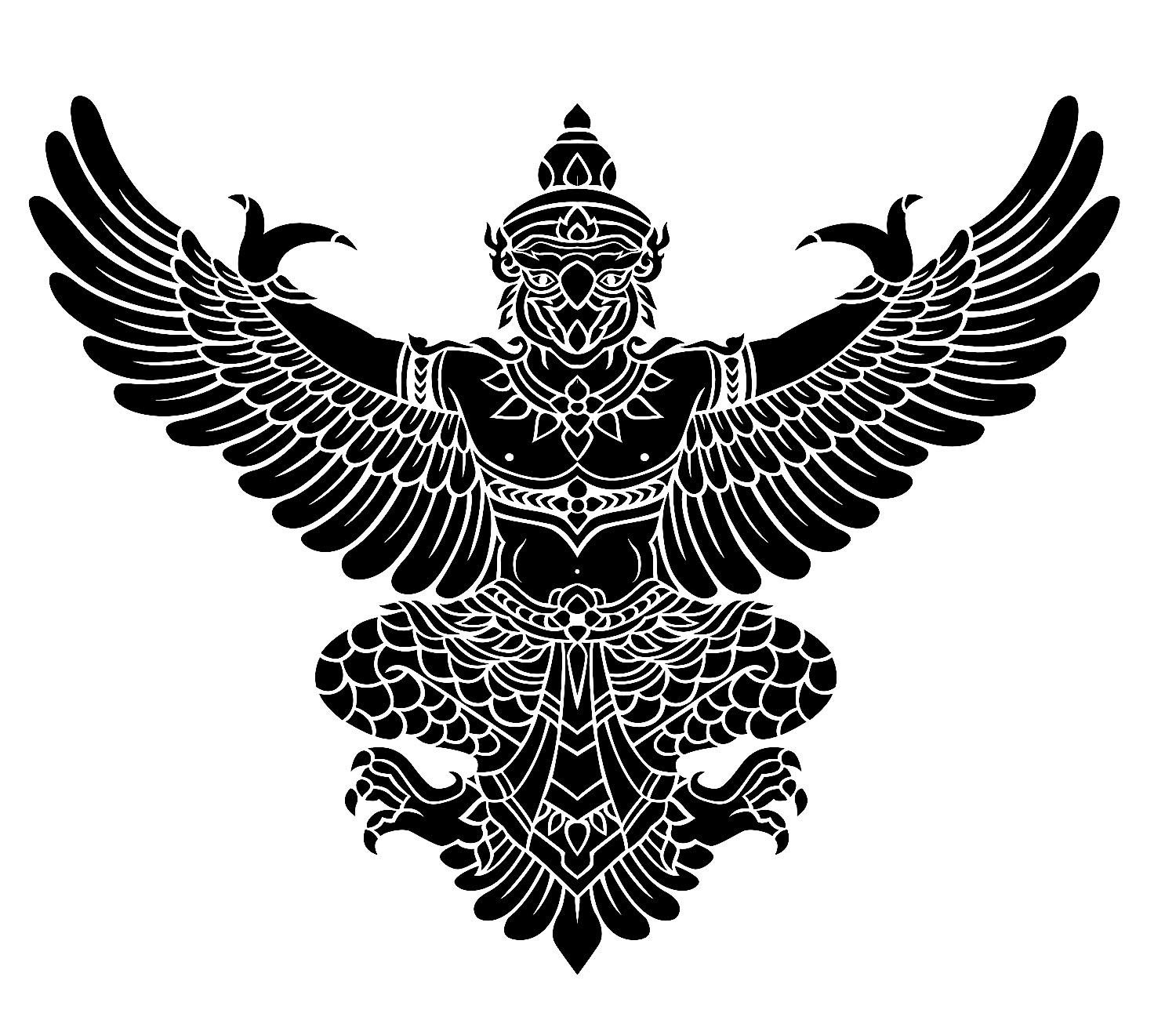
Garudas are not just popular in Bhutan and Tibet, but in India, Nepal, Indonesia, Mongolia, and Thailand.
A Garuda can also manifest as a personal protector or guide.
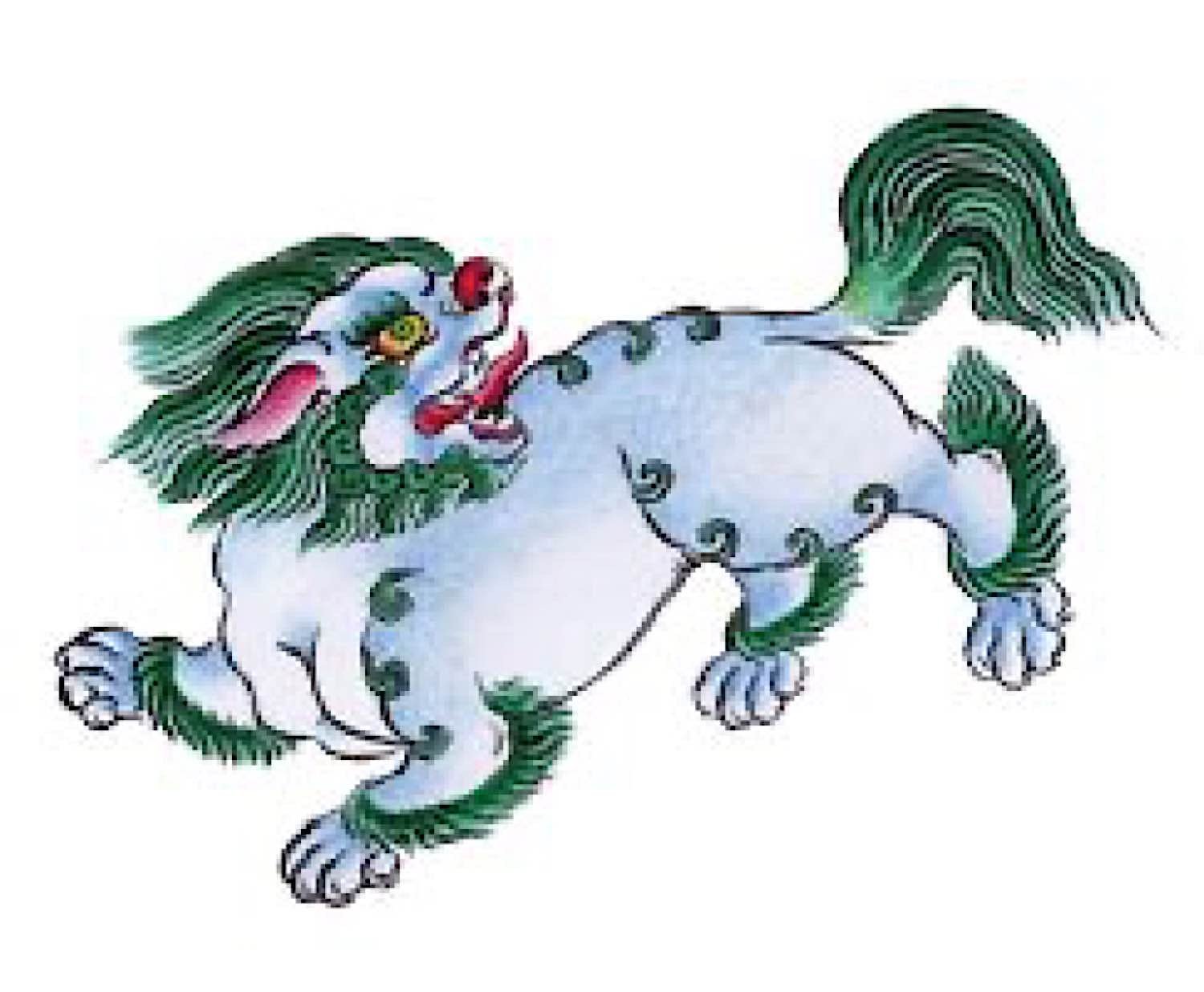
Snow Lion (Seng) — the Purifying and Playful Protector
Snow Lions (Seng) are known to be fierce — yet playful.
In iconography and art, we see them dancing playfully like puppies. But, don’t mistake them for silly. They can become ferocious in an instant! And, definitely don’t confuse them with snow leopards — they hate that!
Snow Lions are especially pre-eminent as they are considered the protector of Buddha. They appear on the thrones of nearly every Buddha! As a symbol, they have even become synonymous with Shakyamuni Buddha!
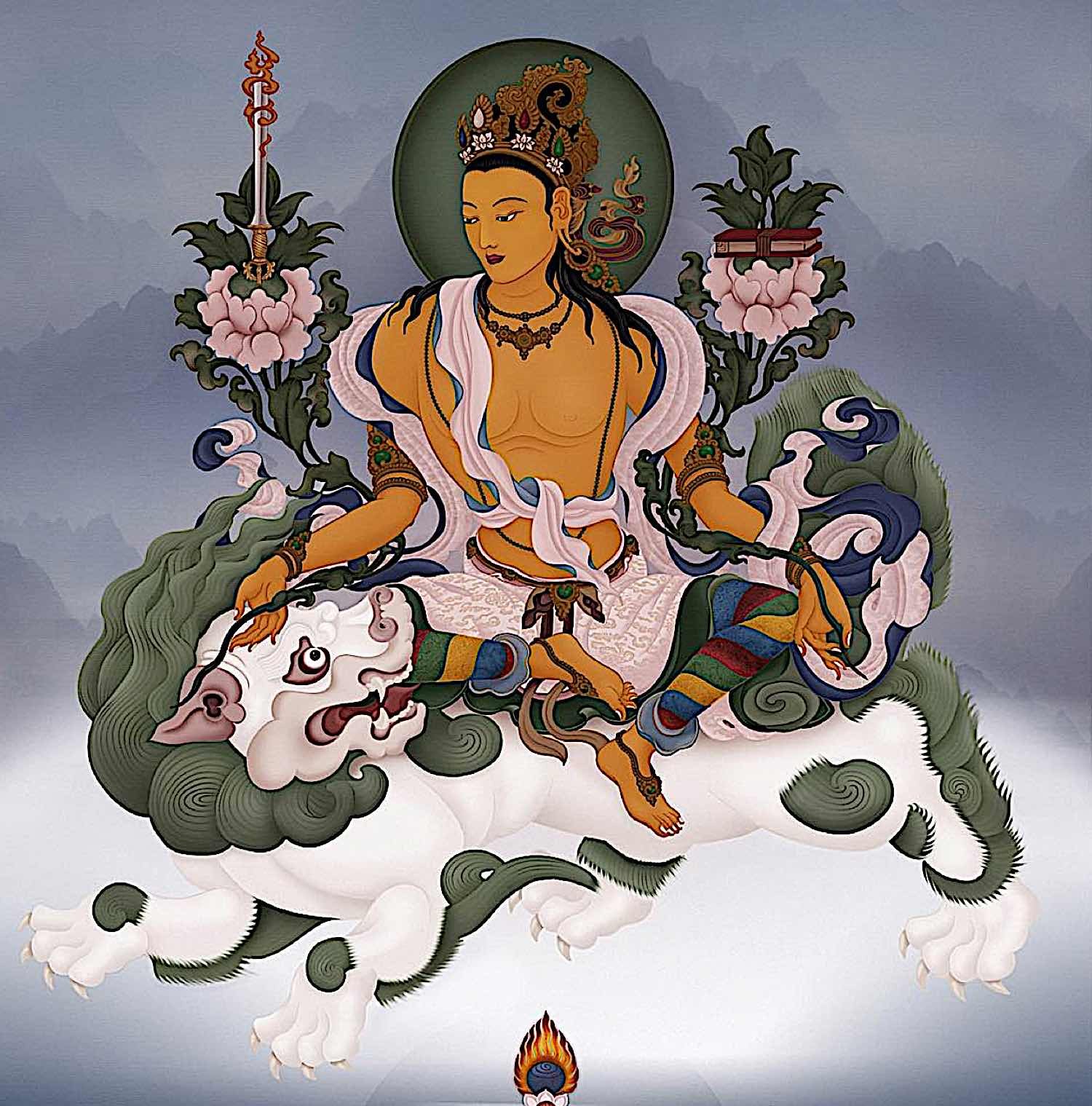
“The Snow-lion (Sengge) stands for vitality, dignity and purity. Its body and mind represent the vibrant energy of goodness and a natural sense of delight.”[2]
The Snow Lion is the protector of the eastern direction, and its element is water. The color white is also associated with this direction, the domain of Vairochana Buddha.
Tibet’s national animal is the Snow Lion. For Tibetans, the snow lion embodies all the characteristics of Tibetan Buddhism: fearless yet gentle; powerful but calm; radiant with good fortune.
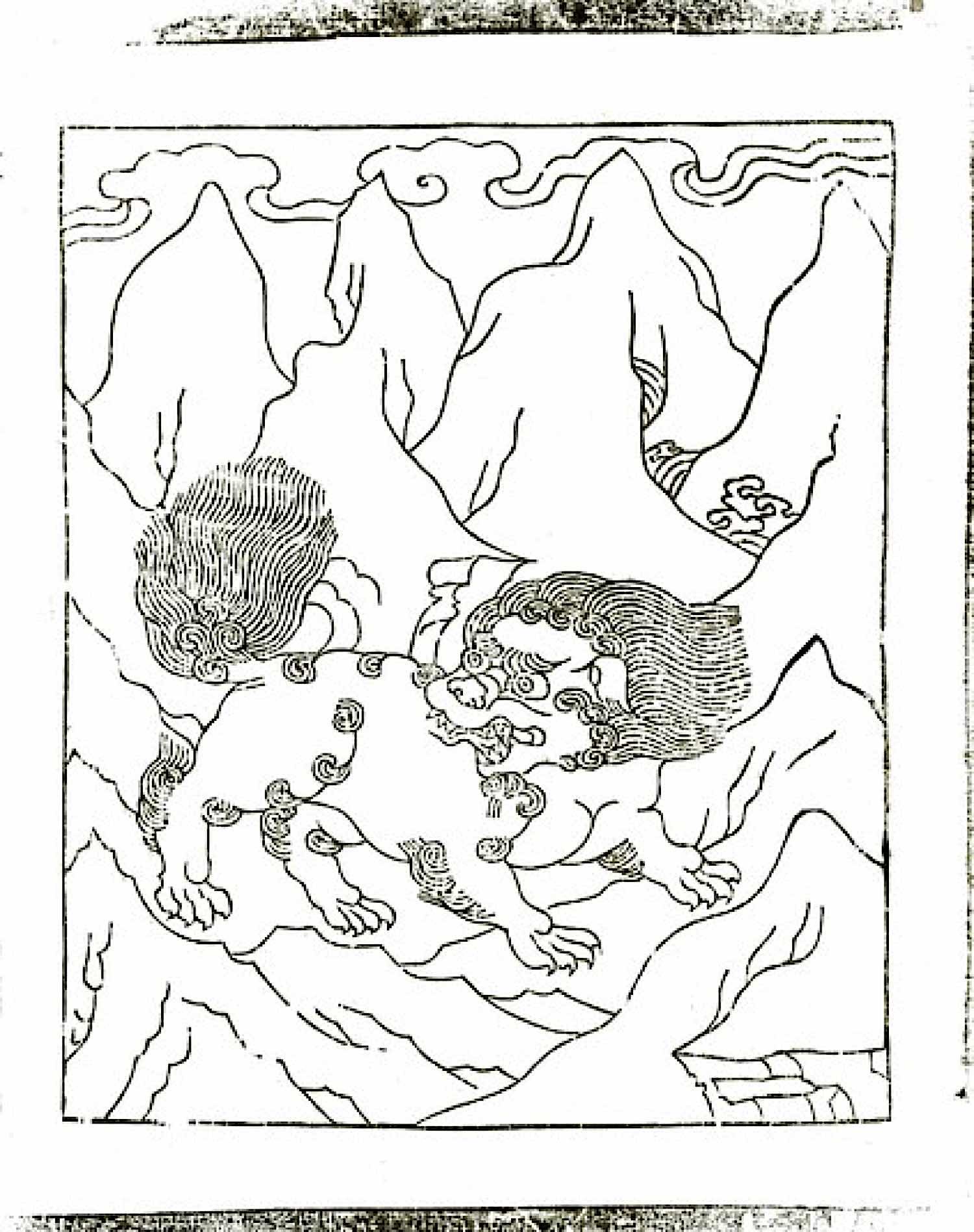
“The body of the Snow Lion is white, while its flowing mane, tail and curls on legs are usually blue or green. While most Snow Lions are gender-neutral in Buddhist art, there are some that are represented as obviously male or female. When represented as a symmetrical pair, the male is on the left and the female on the right. The snow lion is often associated with youthfulness, vibrant energy of goodness, and cheerfulness.” [2]
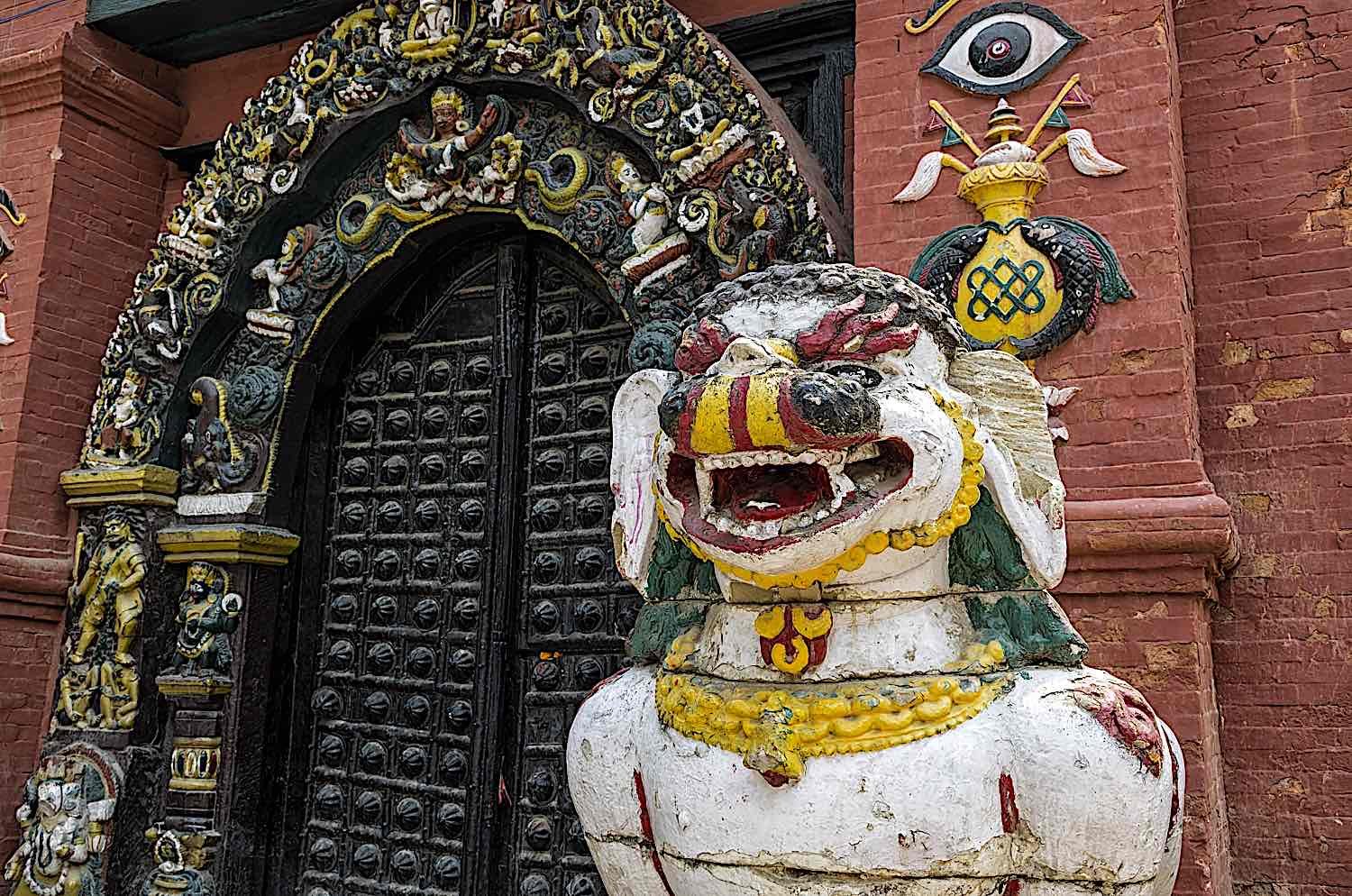
The Snow Lion is also a shapeshifter. It can take on any form, large or small.
Some Snow Lions have the head of a lion and the body of a white horse. Others are purely lion — with thick white fur, edged with a turquoise green mane and tail.
They are known to be gentle and loving — yet fierce when necessary. They mate for life and have a strong bond with their family.

Tigers (To or Tak) — The Fierce and Fearless Protector
Tigers are one of the Four Dignities and the protector of the southern direction. The color yellow is associated with this direction, as is Ratnasambhava Buddha and the Jewel family.
It is on the back of the Tigress that Guru Padmasambhava — in wrathful form as Dorje Drolo — flew to Bhutan to Taksang Monastery. Appropriately, this is how the sacred site received its name Tiger’s Nest. (The Tigress here was the transformation of none other than the great Lady Yeshe Tsogyal!)

Tigers are considered to be among the fiercest and most feared animals in the world. In Tibetan culture, they are also seen as guardian deities — and are revered for their power, strength, and courage.
“The tiger (To) is the symbol of unfathomable power and fearlessness. It overcomes all obstacles and vanquishes ignorance.”[2]
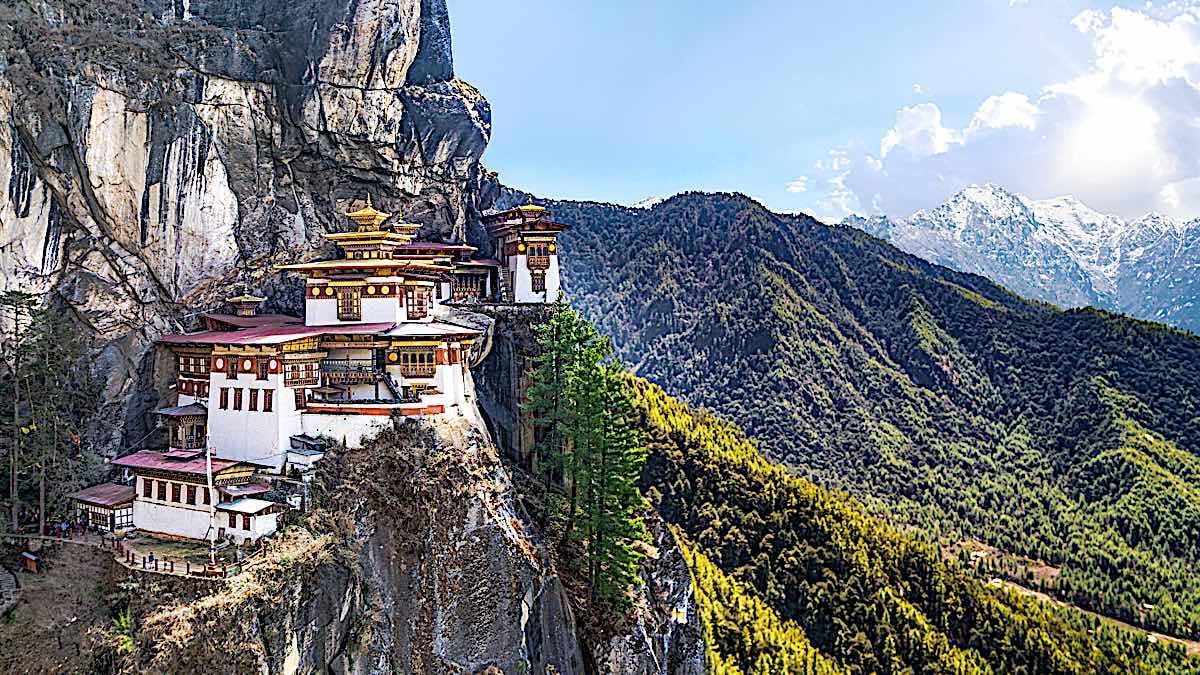
It may seem like a contradiction, but the Tak or To (Tiger) protector is known for kindness and confidence. Imagine a purring Tiger. That’s the picture! But ferocious when needed!
Tibetan Tigers are different than other tigers in that they have six stripes on their foreheads, instead of the usual five. They are also larger, with longer tails.
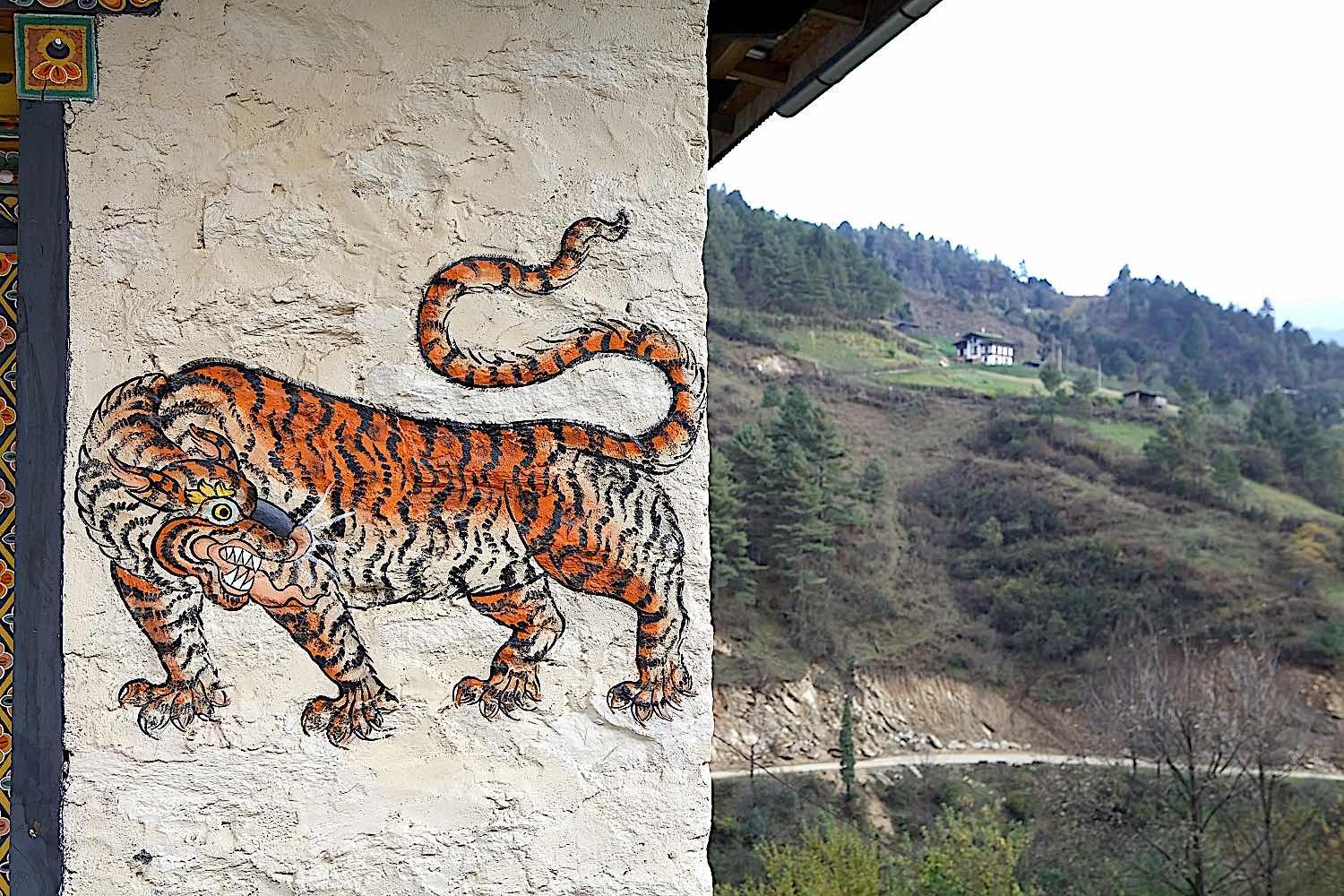
The wrathful deities in Tibetan Buddhism are often sitting on a tiger skin cloth, the back of a tiger, or even wearing a tiger skin — symbolical of this fierce and fearless protector of the south.

Dragons (Yul or Jyotiṣa) — The All-Seeing Wisdom Protector
Dragons are the protector of the western direction, and their element is fire. The color red is associated with this direction, as is Amitabha Buddha.
“The Dragon (Druk) symbolizes achievements, calmness, elegance, and generosity; when it roars in the sky, it opens our eyes and awakens to all the world’s delusions. It is indestructible and energetic and holds in its hand’s precious gems that stand for wealth, prosperity and perfection. In its entire splendor, the Dragon also represents the country Bhutan – Druk Yul – the Thunder Dragon Land.” [2]
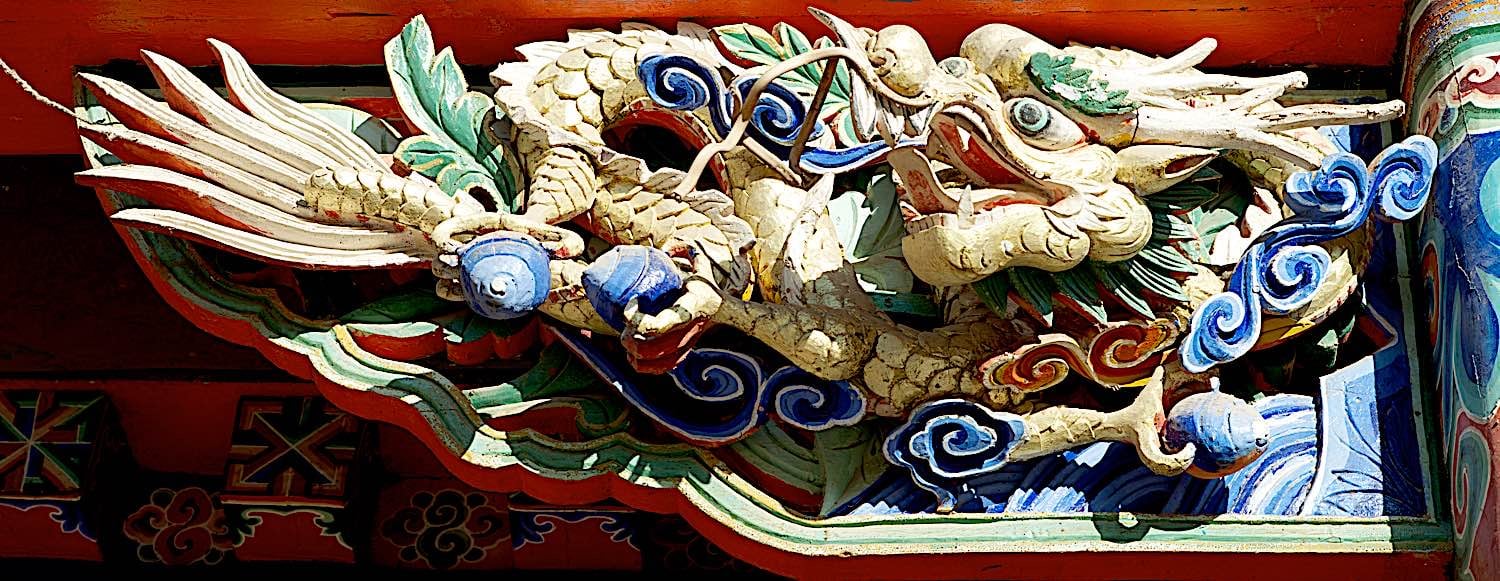
They are seen as benevolent deities that bring rainfall and bring prosperity. They are also seen as the guardians of Tibet’s lakes and rivers.
The dragon (Druk) is the embodiment of primordial power. It represents longevity, awe-inspiring wisdom, wealth and good fortune.
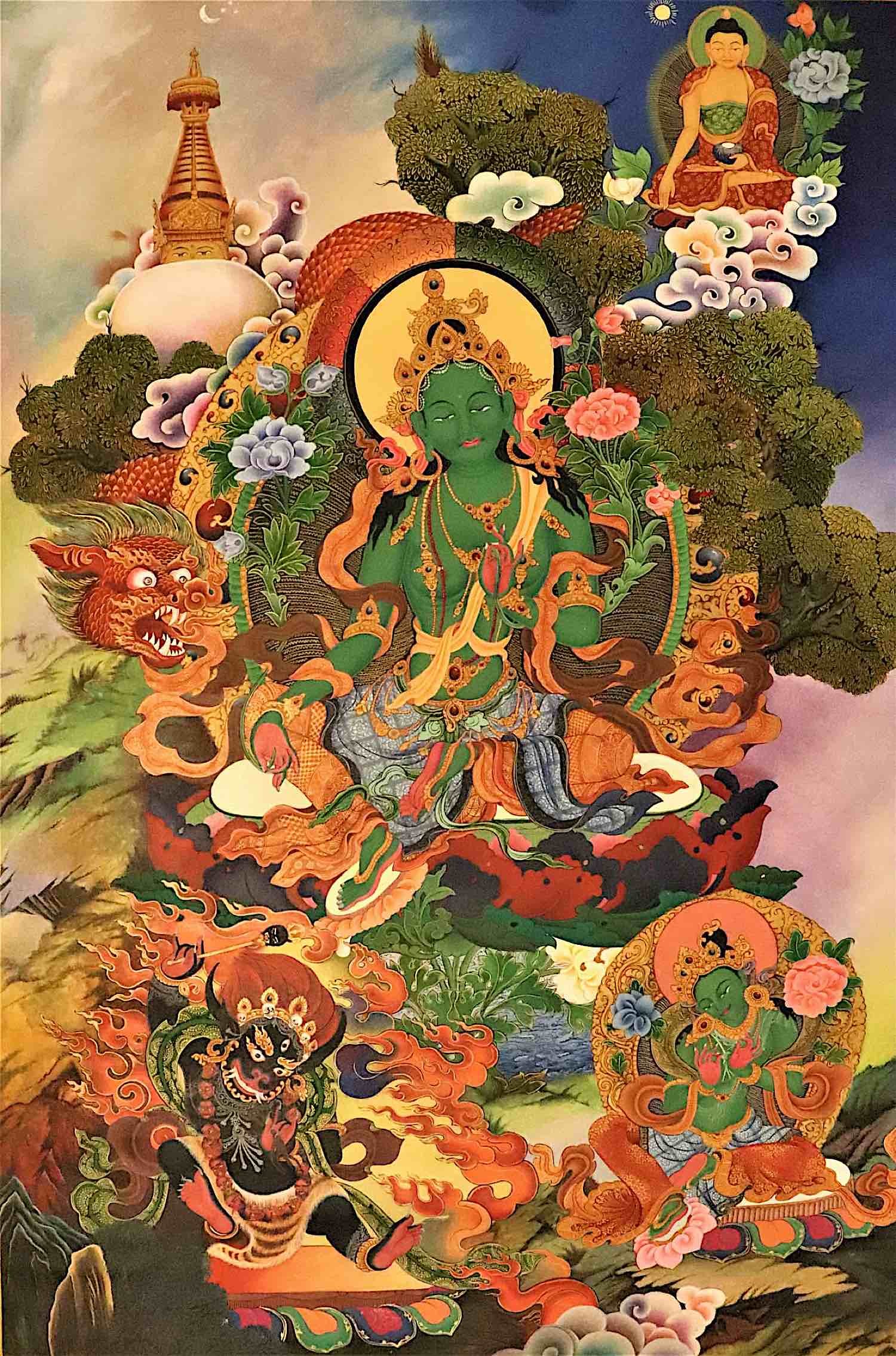
Tibetan dragons are different than other dragons in that they have four legs instead of two. They also have horns on their head, and a jewel in their forehead. And, unlike “western” dragons they fly — but without wings.
Druk is even more pre-eminent in Bhutan, which is literally the land of Dragons:
“Bhutan, often referred to as Druk Yul, or the Land of the Thunder Dragon takes its name from the druk or the Thunder Dragon, a mythical animal revered by the Bhutanese as the symbolic guardian of the country. It’s the national personification of Bhutanese culture, mythology and monarchy. The dragon is prominently featured in Bhutan’s national anthem (Druk tsendhen) and national flag. The dragon is snarling and clutches jewels in its claws. The jewels in the dragon’s claws represent the wealth and prosperity of Bhutan. The snarling dragon represents the male and female deities who are always protecting the country, its King and the people from harm or outside forces that are threatening them.” [2]
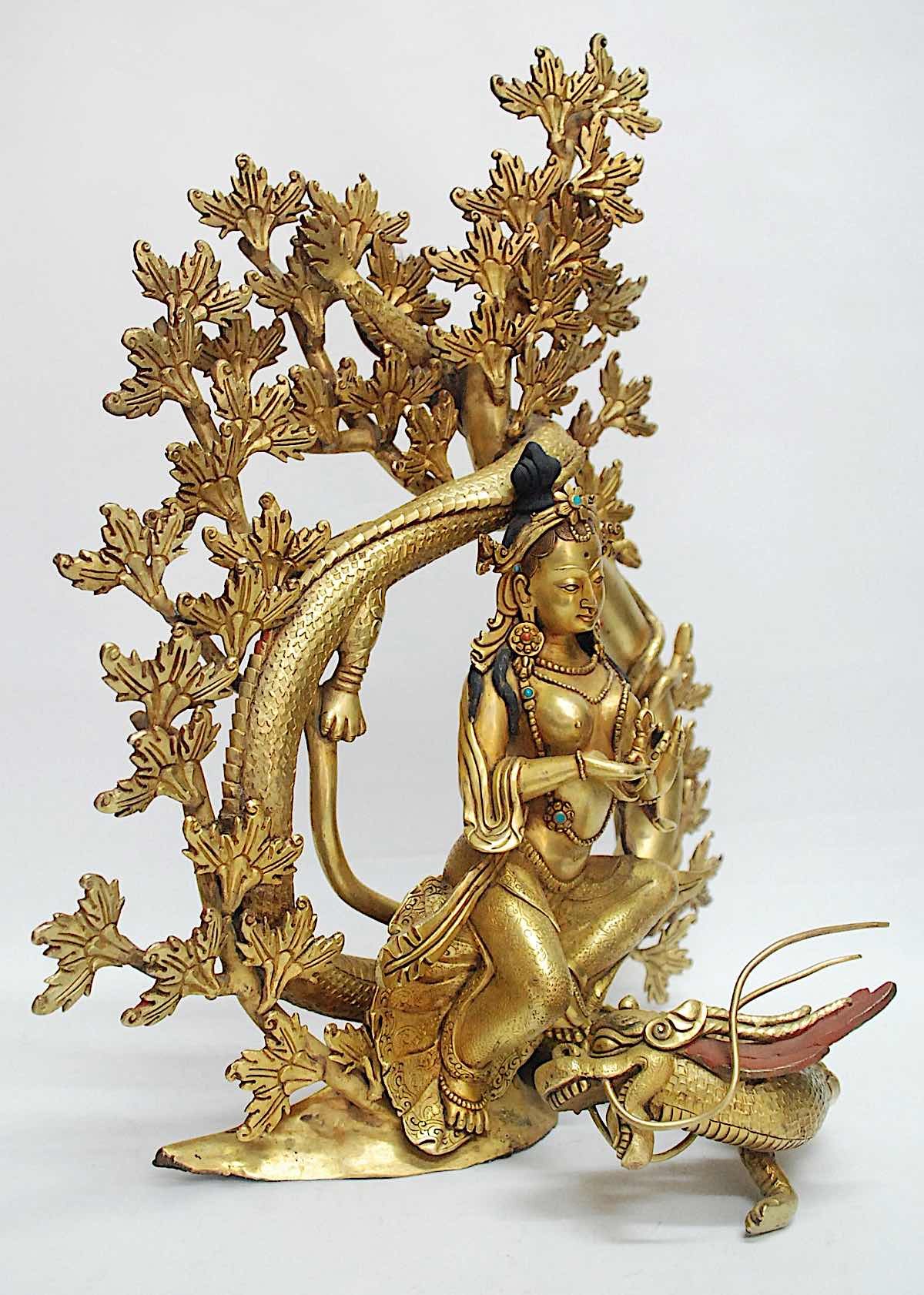
Interestingly, Dragons are found in most regions, mythologies, and cultures of the world — which is quite surprising, considering we’ve yet to discover a dragon fossil. Sometimes they are winged — as in Europe — and sometimes they fly without wings — as in China — most times they are gigantic, other times tiny, usually they are invisible to humans, but it seems they are present in the mind space and mythologies of many cultures.

The Four Dignities plus Raven?
What about the center? In Tibetan Buddhism, the center is a direction. We often speak of ten directions, East, South, West, North, Up, Down and the quarters. The main four guardians are not only the Four Dignities, but their Kings — the Guardian Kings in Buddhism, such as Kubera in the north. (We’ll save that for another story!) But what about the center?
Certainly, in Bhutan, the center belongs to Raven. This is also a precious guardian in Tibet as well since Raven is a symbol representing Black Mahakala, who is an emanation of Chenrezig — the Buddha of the Land of Snows.
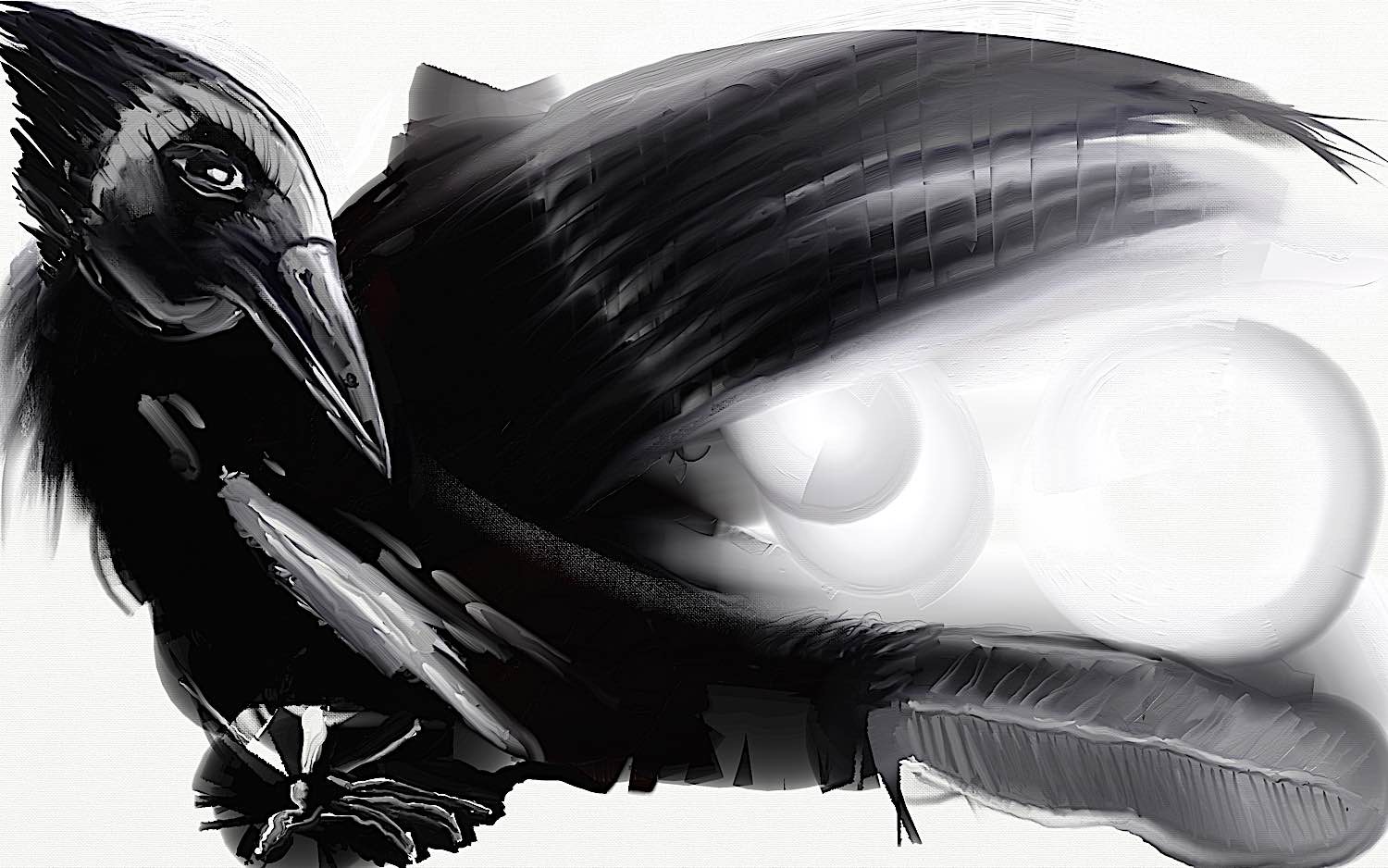
Raven (Legon Jarog Donchen) is the national bird of Bhutan. Killing a Raven is the most heinous of crimes!
“Its shining black feathers, distinctive voice, and playful nature represent power, mystery, wisdom, and intelligence. Known in Bhutan as Legon Jarog Donchen, the raven is seen as an emanation of Mahakala, the wrathful protective deity. It is believed that the guardian deity took the form of a raven to guide the country’s unifier, Zhabdrung Ngawang Namgyel in his trip to Bhutan from Tibet in the 17th century. As the nation’s protector, the raven is considered so sacred that killing a single raven is one of the most heinous crimes.” [2]
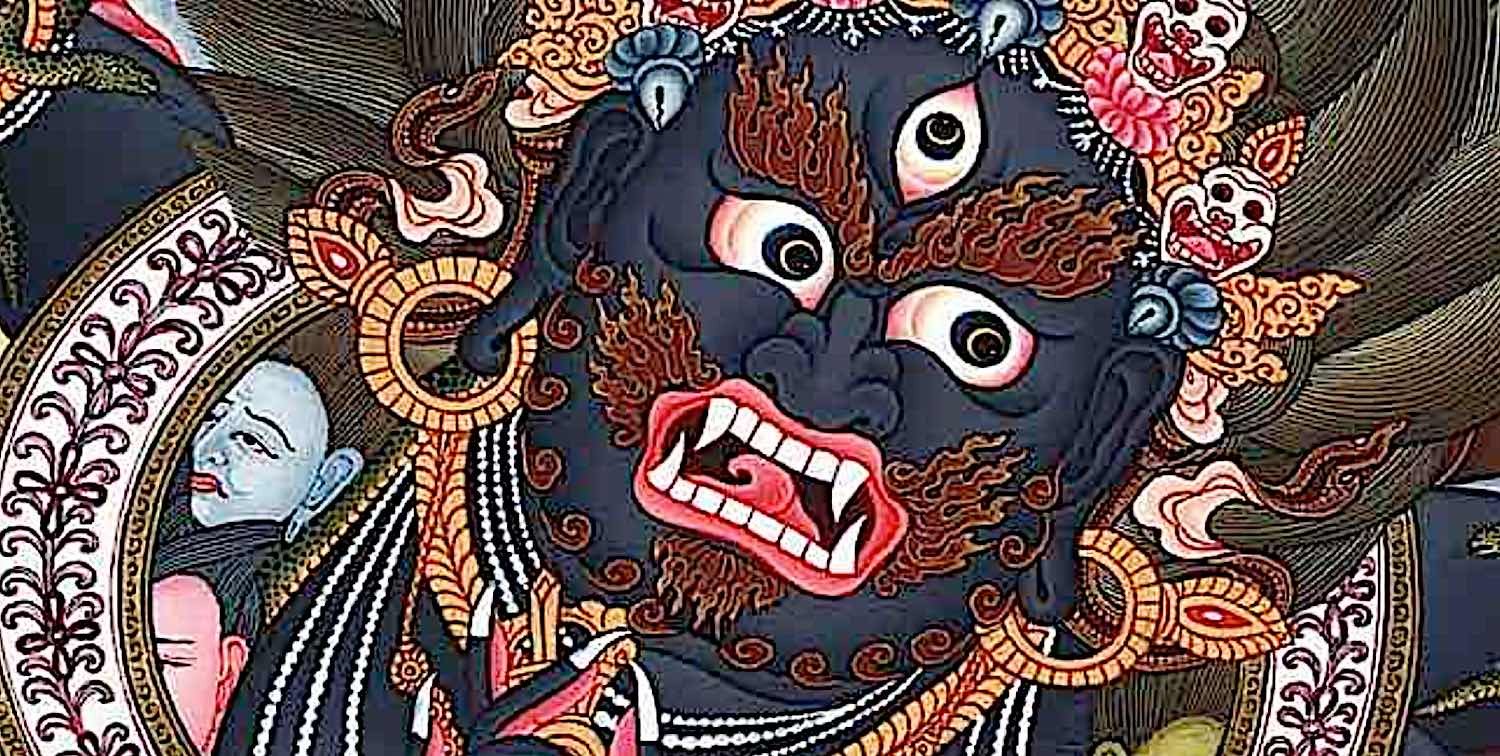
Black Mahakala is a very important protector in Tibet and Bhutan. “He is black in color like the void, and his two eyes are white sun and moon. He has one face and four arms. His right hand holds a curved knife, which symbolizes cutting through attachment and hatred. His left-hand holds a skull cup filled with blood, which represents the transmutation of negativities into wisdom.”
- To read more about the Raven (or Crow) and Black Mahakala, see our feature “Miracles of the Great Black: three men in Black, the Mahakala Brothers, the Dalai Lama and a crow”>>
Tibetan Buddhist Totems: The Four Dignities
The Four Dignities are not just mythical symbols; they are powerful mind guardians that represent profound concepts and energies. By understanding their meanings, we can focus our minds and tap into their power.
When you see a Snow Lion, do you think of Buddha?
When you see a Dragon, do you think of legends of your childhood?
When you see a Garuda — wait, have you ever seen a Garuda? Wow, that would be something special.
In our meditations, of course, we can meet them daily. They are the four great Dignities, the sacred ones. Humor aside, treat them with respect, understanding they are sacred guardians of the Dharma! At the least, remember what they represent.
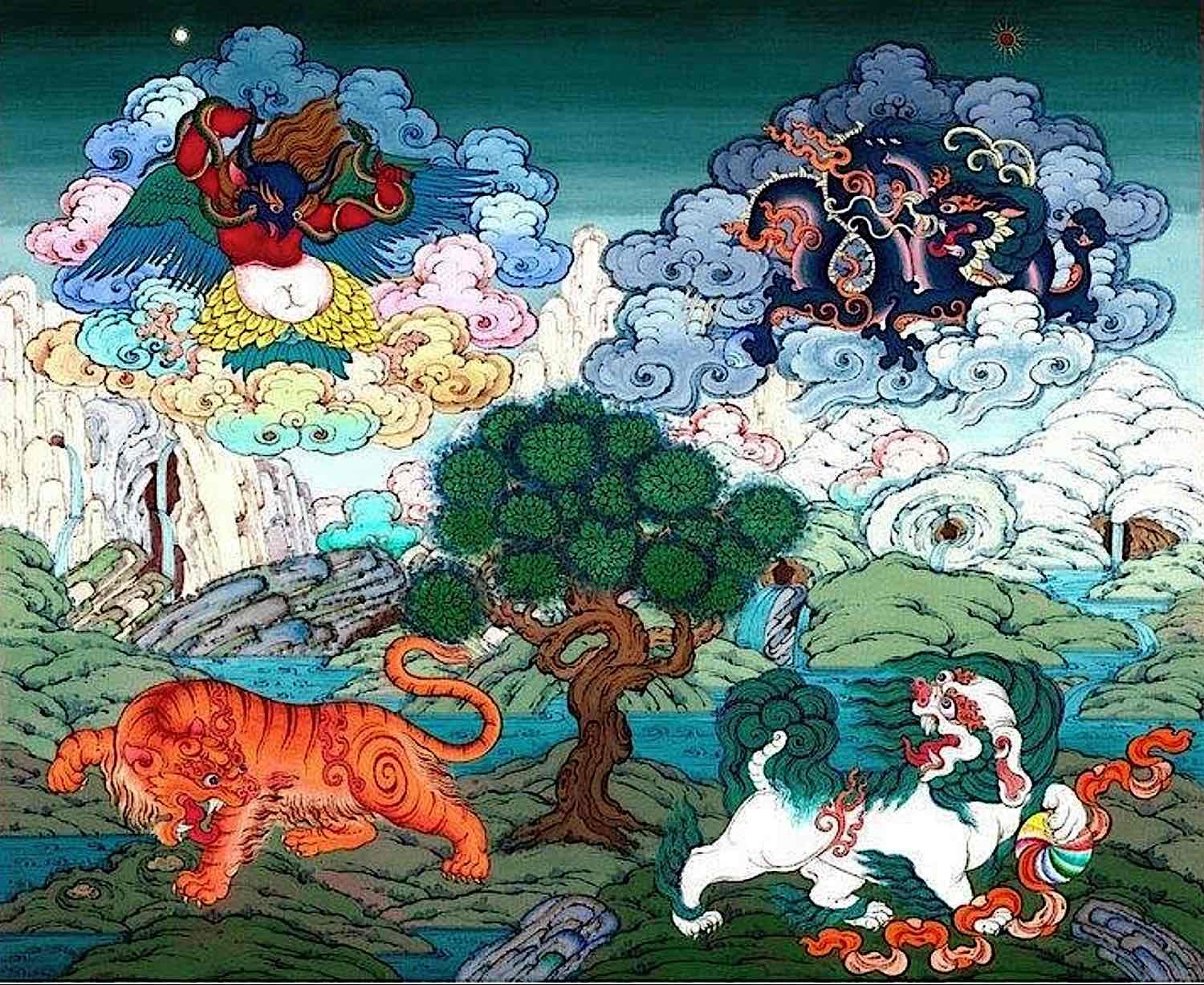
So, now that you know a little bit more about the Four Dignities (plus one!), what do you think they represent? What power do they have for you? Can you see how they could be mind-guardians on your spiritual journey? Do you seem them as metaphors and symbols, or something more tangible in your life? Share your thoughts in the comments below.
Credits
Snowlion caption: By This W3C-unspecified vector image was created with Inkscape. – Emblem_of_Tibet.svg, CC BY-SA 3.0, https://commons.wikimedia.org/w/index.php?curid=9704044
Snow lion dancers: By Michael Eisenriegler – https://www.flickr.com/photos/mikeemesser/5343185016/in/album-72157625792181062/, CC BY 2.0, https://commons.wikimedia.org/w/index.php?curid=40407576
SOURCES
More articles by this author

Guru Rinpoche is ready to answer and grant wishes: “Repeat this prayer continuously” for the granting of wishes

VIDEO: Vajrapani Vajra Armor Mantra: Supreme Protection of Dorje Godrab Vajrakavaca from Padmasambhava
Search
Latest Features
Please support the "Spread the Dharma" mission as one of our heroic Dharma Supporting Members, or with a one-time donation.
Please Help Support the “Spread the Dharma” Mission!

Be a part of the noble mission as a supporting member or a patron, or a volunteer contributor of content.
The power of Dharma to help sentient beings, in part, lies in ensuring access to Buddha’s precious Dharma — the mission of Buddha Weekly. We can’t do it without you!
A non-profit association since 2007, Buddha Weekly published many feature articles, videos, and, podcasts. Please consider supporting the mission to preserve and “Spread the Dharma." Your support as either a patron or a supporting member helps defray the high costs of producing quality Dharma content. Thank you! Learn more here, or become one of our super karma heroes on Patreon.
Lee Kane
Author | Buddha Weekly
Lee Kane is the editor of Buddha Weekly, since 2007. His main focuses as a writer are mindfulness techniques, meditation, Dharma and Sutra commentaries, Buddhist practices, international perspectives and traditions, Vajrayana, Mahayana, Zen. He also covers various events.
Lee also contributes as a writer to various other online magazines and blogs.








